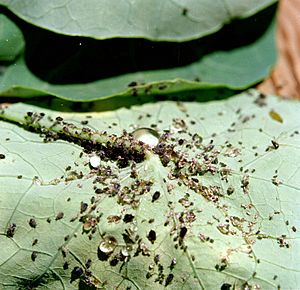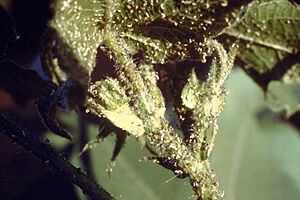Cotton aphid facts for kids
The cotton aphid, also known as the melon aphid, is a very tiny insect. It's a type of aphid, sometimes called a "greenfly." These little bugs belong to a group of insects called Hemiptera, which are known as "true bugs."
Cotton aphids are plant pests because they suck sap from plants. They can be found all over the world and cause problems for many important farm crops. Some of their favorite plants include those in the squash, citrus, and mallow families.
Quick facts for kids Cotton aphid |
|
|---|---|
 |
|
| Adults and nymphs on cotton. | |
| Scientific classification | |
| Genus: |
Aphis
|
| Species: |
gossypii
|
| Synonyms | |
|
|
Contents
Where Do Cotton Aphids Live?
Scientists are not sure where the cotton aphid first came from. However, today you can find them almost everywhere. They live in warm tropical areas and also in cooler temperate zones.
They are common in North and South America, Africa, Australia, and most of Europe. In colder places like northern Europe, they can only survive indoors, often in greenhouses.
What Do Cotton Aphids Look Like?
Wingless Females
The female cotton aphid without wings has an oval-shaped body. It is about two millimeters long, which is very small! Their color can be different shades of green.
Their legs are yellow, and their antennae are about three-quarters the length of their body. The tips of their legs are black. They also have two tube-like parts called siphunculi on their back, which are black and wide at the bottom.
Winged Females
Winged female aphids have a more pointed body shape. Their head and chest area are black. Their belly is yellowish-green with black spots on the sides. Their antennae are longer than those of the wingless females.
Young Aphids (Nymphs)
Young aphids, called nymphs, come in many colors. They can be green, tan, or gray. Often, their head, chest, and wing parts are dark. The end of their body is usually dark green. Their bodies look dull because they are covered in a waxy coating.
Aphid Eggs
Cotton aphid eggs are yellow when first laid. But they quickly turn shiny black.
How Do Cotton Aphids Reproduce?
In warmer parts of the world, like the southern United States, female cotton aphids can have babies without mating. They just keep producing offspring as long as there is enough food and good weather.
In colder regions, their life cycle is more complex. They might use two different types of host plants. A broadleaf tree like Catalpa or Hibiscus could be their main home.
In Europe, they reproduce only without mating, which is called asexual reproduction. Under good conditions, they can have almost 50 generations in one year! In Russia, their eggs can survive winter on wild plants.
Life Cycle Details
Winged aphids then fly to other plants like roses, spinach, or squash. On these plants, they reproduce without mating, allowing huge numbers of aphids to grow very quickly. A female aphid can live for about 20 days and produce up to 85 young aphids.
These young aphids grow up fast. It takes about 20 days when it's 10°C (50°F), but only about four days when it's 30°C (86°F). As fall arrives, winged aphids fly back to their main host trees. There, they mate, and the females lay eggs. These eggs stay through the winter and hatch the next year to start the cycle again.
Who Are Their Natural Enemies?
Many other insects help control cotton aphid populations. These include:
- Midges
- Lacewings
- Syrphid fly larvae
- Anthocorid bugs
- Ladybirds (ladybugs)
Some tiny wasps, like those from the Aphidiinae and Aphelinidae families, are parasitoids of aphids. This means they lay their eggs inside the aphids, which eventually kills them. One promising wasp for pest control is Aphelinus asychis.
What Plants Do Cotton Aphids Attack?

The cotton aphid can feed on a huge variety of plants. Over 60 different host plants are known in Florida alone, and possibly 700 worldwide!
Among vegetables, they can seriously harm:
Other vegetables they attack include pepper, eggplant, okra, and asparagus. They also cause problems for citrus trees, cotton plants, and hibiscus.
Why Are Cotton Aphids a Problem for Farmers?
Cotton aphids cause damage by feeding on the underside of leaves or on new plant shoots. They suck out the plant's juices. This can make the leaves turn yellow and die too soon. Often, the leaves curl and get twisted, which makes it hard for the plant to make food using sunlight.
Aphids also excrete a sticky substance called "honeydew." This honeydew allows a black mold, called sooty mold, to grow on the plants. This mold reduces the quality and amount of crops a farmer can harvest.
Cotton aphids can also spread plant diseases. They carry viruses like crinkle, mosaic, rosette, and CTV. These viruses can be very harmful to plants. Their impact is especially big on crops like zucchini, melons, cucumbers, eggplants, strawberries, cotton, citrus, and mallow.
How Are Cotton Aphids Controlled?
Farmers often use special chemicals called carbamates and organophosphates to fight cotton aphids around the world. These chemicals are designed to kill insects.
Aphids Becoming Resistant
Unfortunately, cotton aphids can become resistant to these insecticides. This means the chemicals stop working as well. Scientists have found that this resistance is linked to changes in two specific genes in the aphids. These genes affect how the aphids' bodies react to the insecticides.
See also
 In Spanish: Pulgón del algodón para niños
In Spanish: Pulgón del algodón para niños

